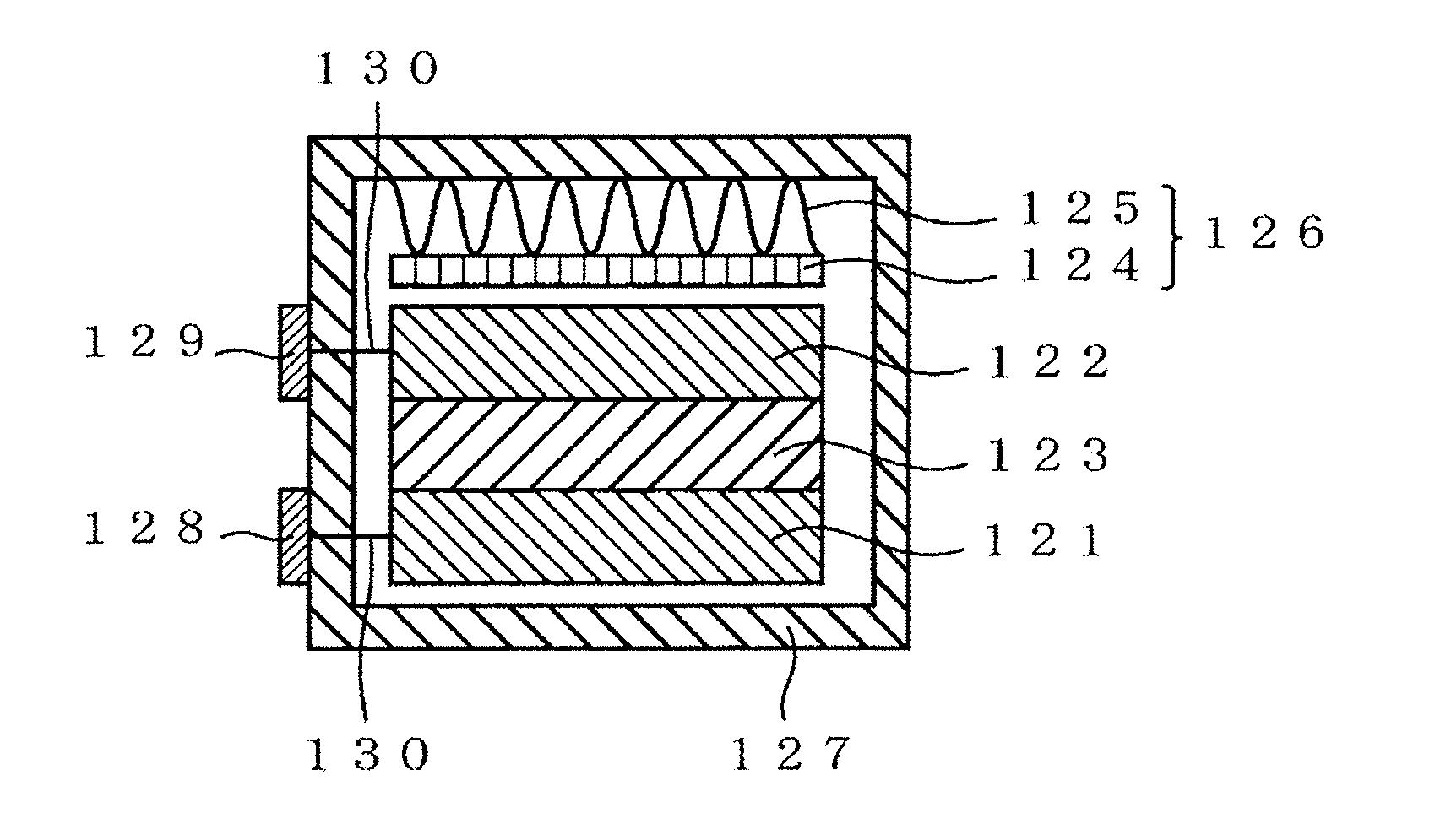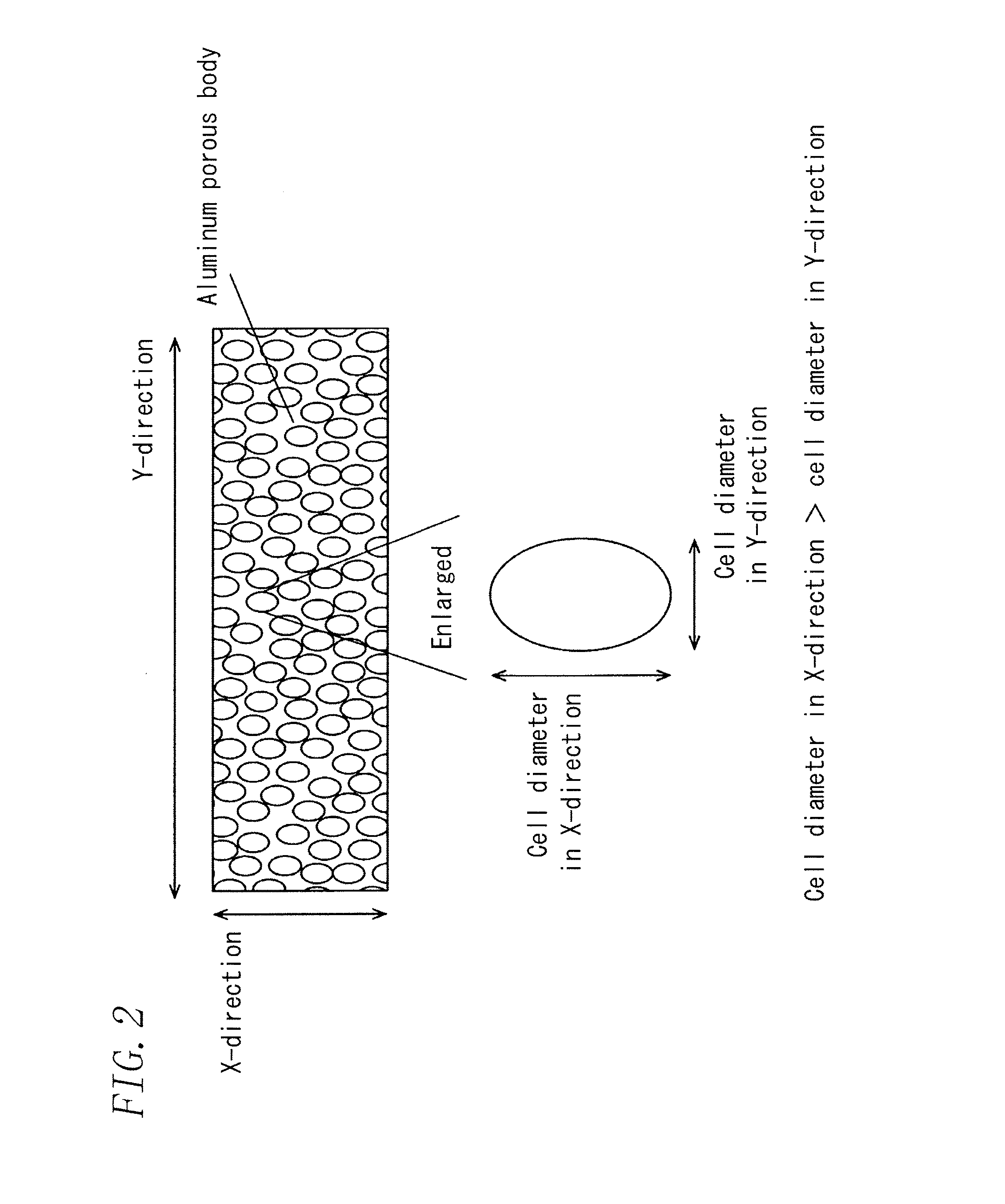Three-dimensional network aluminum porous body, current collector and electrode each using the aluminum porous body, and nonaqueous electrolyte battery, capacitor and lithium-ion capacitor with nonaqueous electrolytic solution, each using the electrode
- Summary
- Abstract
- Description
- Claims
- Application Information
AI Technical Summary
Benefits of technology
Problems solved by technology
Method used
Image
Examples
example 1
(Formation of Conductive Layer)
[0173]A urethane foam having a porosity of 95%, about 50 pores (cells) per inch, a pore diameter of about 550 μm, and a thickness of 1 mm was prepared as a resin molded body and was cut into a 100 mm×30 mm square. A film of aluminum was formed on the surface of the polyurethane foam in a weight per unit area of 10 g / m2 as a conductive layer by the sputtering method.
(Molten Salt Plating)
[0174]The urethane foam having a conductive layer formed on the surface thereof was loaded as a piece of work in a jig having an electricity supply function, and then the jig was placed in a glove box, the interior of which was adjusted to an argon atmosphere and low moisture (a dew point of −30° C. or lower), and was dipped in a molten salt aluminum plating bath (33 mol % EMIC-67 mol % AlCl3) at a temperature of 40° C. In this time, two rollers were placed in the form of a letter inverted V relative to the piece of work, and molten salt plating was performed while widen...
example 2
[0191]An aluminum porous body was prepared in the same manner as in Example 1 except for changing the tension applied to the piece of work in the width direction (X-direction) to 125 kPa in molten salt plating.
[0192]As with Example 1, the cell diameter of the resulting aluminum porous body was measured, and consequently, the cell diameter in the X-direction was 740 μm and the cell diameter in the Y-direction was 407 μm, and the ratio of the cell diameter in the Y-direction to the cell diameter in the X-direction was 0.55.
[0193]The electric resistance of the resulting aluminum porous body was measured, and consequently, the electric resistance in the X-direction was 0.14 Ω·cm and the electric resistance in the Y-direction was 0.21 Ω·cm, and the ratio of the electric resistance in the Y-direction to the electric resistance in the X-direction was 1.5.
example 3
[0194]An aluminum porous body was prepared in the same manner as in Example 1 except that a tension of 50 kPa was applied to the piece of work in the carrying direction without widening the width of the piece of work in molten salt plating and a current collecting lead was disposed at area portion having a width of 5 mm from one end parallel to the X-direction.
[0195]The cell diameter of the resulting aluminum porous body was measured, and consequently, the cell diameter in the X-direction was 498 μm and the cell diameter in the Y-direction was 598 μm, and the ratio of the cell diameter in the Y-direction to the cell diameter in the X-direction was 1.20.
[0196]The electric resistance of the resulting aluminum porous body was measured, and consequently, the electric resistance in the X-direction was 0.20 Ω·cm and the electric resistance in the Y-direction was 0.17 Ω·cm, and the ratio of the electric resistance in the Y-direction to the electric resistance in the X-direction was 0.85.
PUM
| Property | Measurement | Unit |
|---|---|---|
| Thickness | aaaaa | aaaaa |
| Diameter | aaaaa | aaaaa |
| Electrical resistance | aaaaa | aaaaa |
Abstract
Description
Claims
Application Information
 Login to View More
Login to View More - R&D
- Intellectual Property
- Life Sciences
- Materials
- Tech Scout
- Unparalleled Data Quality
- Higher Quality Content
- 60% Fewer Hallucinations
Browse by: Latest US Patents, China's latest patents, Technical Efficacy Thesaurus, Application Domain, Technology Topic, Popular Technical Reports.
© 2025 PatSnap. All rights reserved.Legal|Privacy policy|Modern Slavery Act Transparency Statement|Sitemap|About US| Contact US: help@patsnap.com



